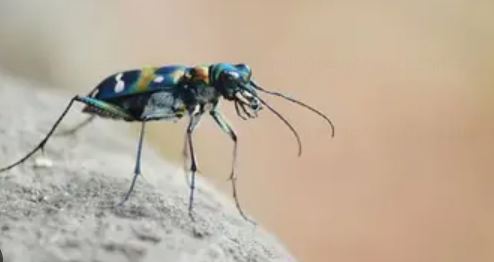Insects’ Sonic Weapon: Mimicking Toxic Moths to Deter Bats
Tiger beetles, renowned for their predatory prowess, have now been found to wield a surprising sonic weapon in their evolutionary arsenal. When faced with the threat of echolocating bats, certain nocturnal tiger beetles respond with high-pitched clicks that closely mimic the warning signals of toxic moths. This acoustic mimicry, detailed in a recent study published in Biology Letters, may be a widespread defense mechanism among night-flying insects.
Sonic Warfare in the Night Sky
The nocturnal world is a battlefield of sound, where bats and insects engage in an evolutionary arms race. Many insects have evolved ears sensitive to bat echolocation, allowing them to detect and evade these aerial predators. Some moths have developed sound-absorbent wings and fuzz to dampen bat sonar, while others emit ultrasonic trills to startle or confuse their pursuers.
Tiger Beetles Join the Acoustic Fray
Researchers have now discovered that certain tiger beetles have joined this acoustic fray, employing a unique strategy to deter bats. When these beetles detect the characteristic clicking of an approaching bat, they rapidly strike their hard forewings against their beating hindwings, producing ultrasonic clicks that eerily resemble the warning signals of toxic moths.
Mimicry, Not Toxicity: A Deceptive Defense
Initially, scientists hypothesized that these clicks might serve as a warning of the beetles’ own toxicity, as they produce defensive chemicals and often sport bright colors as a deterrent to other predators. However, laboratory experiments revealed that bats readily consumed tiger beetles, indicating that their chemical defenses were ineffective against these mammalian predators.
Acoustic Analysis Confirms Mimicry
Further analysis of the ultrasonic clicks revealed a striking similarity to the warning signals of co-occurring tiger moths, known to be unpalatable to bats. This finding strongly suggests that tiger beetles have evolved to mimic the acoustic signals of these toxic moths, deceiving bats into avoiding them.
A New Frontier in Evolutionary Ecology
This discovery of acoustic mimicry in tiger beetles represents a significant advancement in our understanding of predator-prey interactions and the diverse strategies employed by insects to survive in the nocturnal world. It highlights the importance of considering acoustic signals alongside visual and chemical cues in the study of animal communication and defense mechanisms.
Key Learning Points
| Learning Point | Description |
|---|---|
| Acoustic Mimicry in Tiger Beetles | Some tiger beetles use acoustic mimicry to deter bats by mimicking the warning signals of toxic moths. |
| Evolutionary Arms Race | Bats and insects are engaged in an evolutionary arms race, with insects evolving various defense mechanisms to avoid predation. |
| Ultrasonic Clicks as Warning Signals | Tiger beetles produce ultrasonic clicks by striking their forewings against their hindwings. |
| Implications for Predator-Prey Interactions | This discovery highlights the importance of considering acoustic signals in the study of animal communication and defense. |

Basant Kumar Sahoo is a seasoned writer with extensive experience in crafting tech-related articles, insightful editorials, and engaging sports content. With a deep understanding of technology trends, a knack for thought-provoking commentary, and a passion for sports, Basant brings a unique blend of expertise and creativity to his writing. His work is known for its clarity, depth, and ability to connect with readers across diverse topics.



